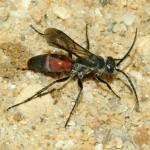Though regarded as nationally scarce, this species can be relatively frequent on the heaths of Dorset, Hampshire, West Sussex, Surrey and the East Anglian Brecks (Suffolk and Norfolk). Other records exist for Essex and Sidmouth, Devon. On the Channel Islands, it is recorded from Jersey, with recent information for two sites (M E Archer).
Falk (1991) placed this species in the Nationally Notable category (Nb).
Day, 1988 is the standard work for identifying British Pompilidae. Wiśniowski, B., 2009 is also useful.
A strong association with heathland is shown, although it can occasionally turn up in some sandy habitats (such as sandpits), and railway cuttings.
Possibly single-brooded; May (or perhaps late April) until September.
Like other Evagetes, this species is probably a cleptoparasite of fossorial pompilid species, though there are a number of dubious accounts of it hunting spiders and digging its own nests (see Richards & Hamm 1939). Also, there are questionable reports of it cleptoparasitising non-fossorial pompilids such as Arachnospila minutula and A. spissa.
The wasps visit flowers such as those of wild carrot.
1997


